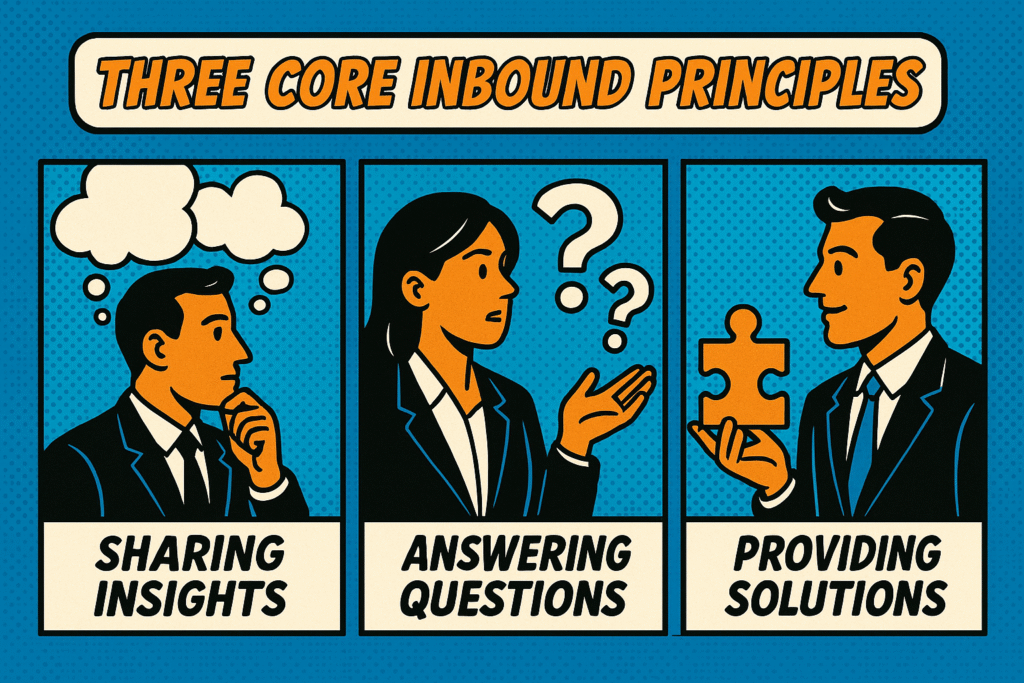By Social-Hire.com
Struggling to convert your social media efforts into actual business results? You’re not alone. We work with founders across the UK, US, and Canada who come to us frustrated because their social selling feels like shouting into the void instead of building meaningful business relationships.
The problem isn’t social selling itself—it’s the approach. Most businesses get caught up in the direct pitch trap, bombarding prospects with sales messages that drive people away rather than drawing them in.
Social selling, the inbound way, flips this entire approach on its head. Instead of chasing prospects with cold outreach, you attract them by providing genuine value first. This methodology aligns perfectly with how modern B2B decision-makers actually want to engage—they prefer to research, educate themselves, and build trust before making purchase decisions. When we help our clients shift to this approach, they typically see their response rates improve significantly because they’re working with the natural buying process rather than against it.
We’ll walk you through exactly what social selling the inbound way means, how it differs from traditional social selling approaches, and most importantly, how to implement it effectively in your business.
You’ll discover the core principles that make this approach work, practical strategies you can start using today, and real examples of how B2B firms are winning new clients by putting value first. We’ve been helping professional services firms, SaaS companies, and recruitment agencies master this approach since 2012, so we know what actually delivers results.
Understanding Social Selling the Inbound Way
Social selling the inbound way means using social media platforms to attract and engage potential customers by providing value and insights rather than direct sales pitches (Source: Asset Digital). This approach aligns with inbound marketing principles, focusing on building relationships and trust through helpful content and interactions. Instead of interrupting prospects with cold messages, you create content and engage in ways that naturally draw them to your business.

The traditional social selling approach often relies heavily on direct outreach—sending connection requests followed by immediate sales pitches, or commenting on posts solely to promote your services. We see this fail time and time again because it focuses on what you want (a sale) rather than what your prospect needs (solutions to their problems). When you take an inbound approach, you’re addressing their pain points and providing insights that help them make better decisions, whether they work with you or not.
The key difference lies in your intent and strategy. Our social media lead generation approach emphasises building genuine relationships first. When we work with clients on social selling strategies, we help them understand that successful social selling isn’t about closing deals on social platforms—it’s about opening conversations with the right people who are already experiencing the problems you solve.

Core Principles of Inbound Social Selling
The foundation of successful inbound social selling rests on three core principles that we’ve refined through years of working with B2B clients. First is the value-first approach—everything you share, comment on, or discuss should provide genuine value to your target audience. This means answering questions on LinkedIn, sharing insights about industry trends, or creating content that helps prospects solve problems, even if they never become clients.

Relationship building forms the second pillar of this approach. Instead of treating social media as a direct sales channel, view it as a networking platform where you build long-term professional relationships.
We teach our clients to engage authentically with their prospects’ content, share relevant opportunities that might benefit others in their network, and position themselves as helpful industry resources. Our social selling guide details specific tactics for nurturing these professional relationships effectively.
Content-centric strategy serves as the third principle, utilising content marketing to attract and engage prospects throughout their decision-making process (Source: DealHub). This involves creating and sharing targeted content that addresses common pain points in your industry, guides prospects through solution evaluation, and demonstrates your expertise without overtly selling.
The content should be valuable enough that prospects would willingly consume it even if they weren’t considering your services.

Implementing Inbound Social Selling Strategies
Getting started with inbound social selling requires a systematic approach that we’ve developed through working with hundreds of B2B firms. Begin by optimising your social media profiles to reflect your value proposition and attract potential customers (Source: GaggleAMP).
Your LinkedIn headline shouldn’t just state your job title—it should communicate the specific problems you solve for your target market. We work with clients to craft profiles that immediately convey expertise and approachability.

Social media listening forms the backbone of effective implementation. Monitor relevant conversations across platforms where your prospects gather, and engage by offering helpful advice or resources (Source: DealHub).
This isn’t about lurking and waiting to pounce with a sales pitch—it’s about genuinely participating in industry discussions and building your reputation as someone who provides valuable insights. Our lead generation strategies show how consistent, helpful engagement naturally attracts prospects to your business.
Content creation and curation should address specific pain points your target audience faces. We help our clients develop content calendars that mix original insights with carefully curated industry resources. The key is consistency—prospects need to see you regularly providing value before they’ll trust you with their business challenges. Share case studies (without revealing anything confidential), industry trend analysis, and practical tips that your prospects can implement immediately.
- Audit and optimise all social media profiles for your target audience
- Set up monitoring tools to track relevant industry conversations and keywords
- Develop a content calendar that provides consistent value to prospects
- Create systematic engagement routines for interacting with prospects’ content
- Establish metrics to track relationship development and engagement quality
Real-World Examples of Inbound Social Selling
Educational content sharing represents one of the most effective forms of inbound social selling we see working across different industries. Instead of posting about your latest service offering, share insights about industry challenges, solution frameworks, or implementation best practices.
For example, a management consultant might share a framework for evaluating digital transformation initiatives, while a recruitment agency owner could post about emerging hiring trends and their implications for different sectors.
Strategic engagement in industry discussions showcases your expertise without explicit selling. When someone in your network posts about a challenge you’ve helped clients solve, resist the urge to immediately pitch your services.
Instead, share a thoughtful perspective, ask clarifying questions, or offer a relevant resource. Our B2B lead generation approach emphasizes building credibility through helpful contributions to industry conversations.
Value-driven networking involves connecting with prospects and peers by offering something useful rather than asking for something. This might mean introducing two people in your network who could help each other, sharing a relevant opportunity with someone in your audience, or offering to review a prospect’s approach to a challenge they’ve mentioned publicly.
We’ve seen clients build substantial pipelines by consistently being helpful to their professional networks.

Common Mistakes to Avoid in Inbound Social Selling
Over-pitching remains the most common mistake we see when B2B firms attempt social selling. Sending too many cold outreach messages or connection requests leads to low response rates and potential platform restrictions (Source: GaggleAMP).
We’ve worked with clients who’ve damaged their reputation by being too aggressive in their approach. The golden rule we teach: if you wouldn’t say it to someone at a networking event within the first five minutes of meeting them, don’t say it in a LinkedIn message.

Lack of personalisation in your content and outreach efforts significantly reduces engagement and conversion rates. Generic messages that could apply to anyone in your industry immediately signal that you haven’t done your homework about the specific prospect or their business challenges. Our social selling insights emphasise the importance of researching prospects and tailoring your approach to their specific situation and needs.
Inconsistent engagement patterns hurt your credibility and effectiveness. Prospects notice when someone suddenly appears in their network, engages heavily for a week, then disappears completely.
We help our clients develop sustainable engagement routines that they can maintain long-term. It’s better to consistently engage at a moderate level than to have intense bursts followed by long periods of silence.

Measuring Success in Inbound Social Selling
Successful inbound social selling requires tracking metrics beyond simple follower counts or likes. We help our clients focus on meaningful business outcomes that directly tie to revenue generation.
Response rates to your social outreach, meeting conversion rates from social connections, and ultimately, the business generated from social channels provide the clearest picture of your social selling effectiveness. These metrics align with our outcome-oriented approach—we measure success by business results, not vanity metrics.
Relationship development metrics offer insights into the health of your social selling efforts. Track how many meaningful professional relationships you’re building each month, the quality of interactions you’re having, and whether these relationships are progressing toward business discussions. Our sales lead strategies emphasise the importance of relationship progression tracking to ensure your efforts are moving toward business outcomes.
Content engagement analytics help you understand what resonates with your target audience and refine your approach accordingly. Monitor which types of posts generate the most thoughtful comments from prospects, what content gets shared by your ideal clients, and which topics spark meaningful conversations.
This data informs your content strategy and helps you focus on the approaches that actually engage your target market.
- Track response rates and meeting conversions from social connections
- Monitor relationship development and progression toward business discussions
- Analyse content engagement quality, not just quantity metrics
- Measure business outcomes: leads, meetings, and revenue from social channels
Getting Started with Your Inbound Social Selling Strategy
Beginning your inbound social selling journey requires a strategic foundation that aligns with your overall business development goals. Start by clearly defining your target audience and understanding where they spend their time on social media.
We work with clients to develop detailed buyer personas that guide their social selling efforts, ensuring they’re investing time and energy in the platforms and conversations that matter most to their specific market.
Audit your current social media presence to ensure it reflects your professional expertise and value proposition. Your profiles should immediately convey what you do, who you help, and what makes you different from competitors.
We’ve helped hundreds of founders and partners optimise their social presence to attract the right prospects while filtering out poor-fit opportunities. This initial foundation work significantly improves the effectiveness of all your subsequent social selling efforts.
Create a sustainable engagement and content strategy that you can maintain consistently over time. Social selling success comes from regular, helpful interactions rather than sporadic bursts of activity. We help our clients develop realistic schedules that fit their busy work lives while ensuring they remain visible and helpful to their target audience. The key is starting with a manageable approach that you can execute consistently, then scaling up as you see results.
Ready to transform your social selling approach and start attracting qualified prospects instead of chasing them? We’d love to help you develop a strategy that aligns with how your prospects actually want to engage.
Book a call with our team to discuss how we can help you implement these inbound social selling principles in your business, or join one of our free webinars where we share the latest strategies that are working for B2B firms right now.






